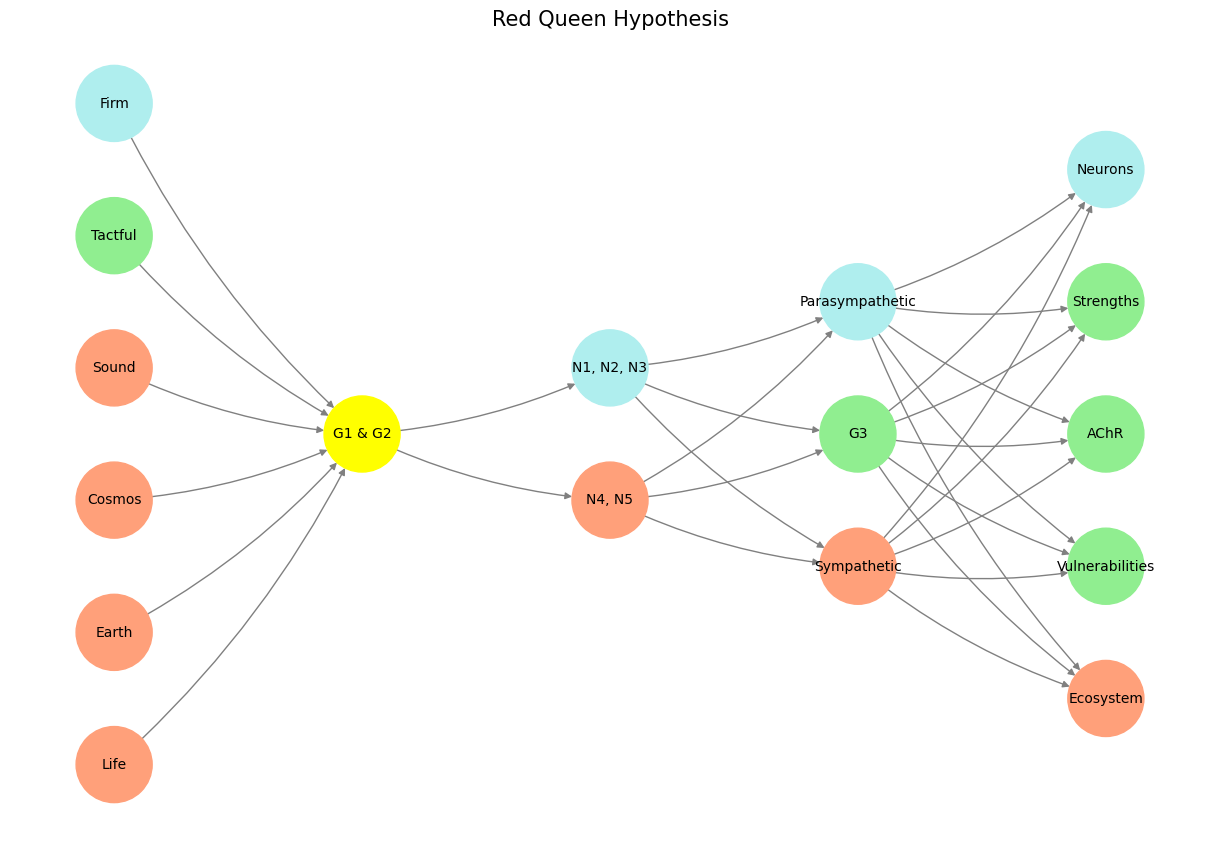Risk#
Let’s address a multifaceted request, let’s start with the proposed renaming of the coded network below. Our current names are functional and thematic, but they can benefit from refinement for clarity and thematic resonance.
Proposed Renaming of the Network Layers and Nodes:#
Pre-Input Layer (Backend):
Life → Vital Core
Earth → Geosphere
Cosmos → Celestial Nexus
Sound → Resonance
Tactful → Diplomatic
Firm → Resolute
Yellowstone Layer (Interface):
G1 & G2 → Catalysts of Emergence
Input Layer (User):
N4, N5 → Adaptive Inputs
N1, N2, N3 → Primordial Signals
Hidden Layer (Combinatorial Space):
Sympathetic → Adversarial Drive
G3 → Iterative Core
Parasympathetic → Cooperative Stability
Output Layer (Personalized Information):
Ecosystem → Systemic Equilibrium
Vulnerabilities → Adaptive Challenges
AChR → Neurochemical Interface
Strengths → Robust Attributes
Neurons → Cognitive Framework
Show code cell source
import numpy as np
import matplotlib.pyplot as plt
import networkx as nx
# Define the neural network structure
def define_layers():
return {
'Pre-Input': ['Life', 'Earth', 'Cosmos', 'Sound', 'Tactful', 'Firm'],
'Yellowstone': ['G1 & G2'],
'Input': ['N4, N5', 'N1, N2, N3'],
'Hidden': ['Sympathetic', 'G3', 'Parasympathetic'],
'Output': ['Ecosystem', 'Vulnerabilities', 'AChR', 'Strengths', 'Neurons']
}
# Assign colors to nodes
def assign_colors(node, layer):
if node == 'G1 & G2':
return 'yellow'
if layer == 'Pre-Input' and node in ['Tactful']:
return 'lightgreen'
if layer == 'Pre-Input' and node in ['Firm']:
return 'paleturquoise'
elif layer == 'Input' and node == 'N1, N2, N3':
return 'paleturquoise'
elif layer == 'Hidden':
if node == 'Parasympathetic':
return 'paleturquoise'
elif node == 'G3':
return 'lightgreen'
elif node == 'Sympathetic':
return 'lightsalmon'
elif layer == 'Output':
if node == 'Neurons':
return 'paleturquoise'
elif node in ['Strengths', 'AChR', 'Vulnerabilities']:
return 'lightgreen'
elif node == 'Ecosystem':
return 'lightsalmon'
return 'lightsalmon' # Default color
# Calculate positions for nodes
def calculate_positions(layer, center_x, offset):
layer_size = len(layer)
start_y = -(layer_size - 1) / 2 # Center the layer vertically
return [(center_x + offset, start_y + i) for i in range(layer_size)]
# Create and visualize the neural network graph
def visualize_nn():
layers = define_layers()
G = nx.DiGraph()
pos = {}
node_colors = []
center_x = 0 # Align nodes horizontally
# Add nodes and assign positions
for i, (layer_name, nodes) in enumerate(layers.items()):
y_positions = calculate_positions(nodes, center_x, offset=-len(layers) + i + 1)
for node, position in zip(nodes, y_positions):
G.add_node(node, layer=layer_name)
pos[node] = position
node_colors.append(assign_colors(node, layer_name))
# Add edges (without weights)
for layer_pair in [
('Pre-Input', 'Yellowstone'), ('Yellowstone', 'Input'), ('Input', 'Hidden'), ('Hidden', 'Output')
]:
source_layer, target_layer = layer_pair
for source in layers[source_layer]:
for target in layers[target_layer]:
G.add_edge(source, target)
# Draw the graph
plt.figure(figsize=(12, 8))
nx.draw(
G, pos, with_labels=True, node_color=node_colors, edge_color='gray',
node_size=3000, font_size=10, connectionstyle="arc3,rad=0.1"
)
plt.title("Red Queen Hypothesis", fontsize=15)
plt.show()
# Run the visualization
visualize_nn()


Fig. 11 The names in our proposal aim to preserve the meaning while adding conceptual depth and precision, aligning with the themes of the Red Queen Hypothesis and the nervous system’s evolutionary architecture.#
The Red Queen Hypothesis as Dynamic Equilibrium#
The Red Queen Hypothesis posits that species must continually adapt and evolve not merely for advantage but to maintain their existence in a constantly changing environment. This principle transcends biology, finding resonance across ecosystems, cellular dynamics, societal structures, and human interactions.
Empirical Foundations#
Ecological Evidence:
The evolutionary arms race between predators and prey demonstrates a perpetual balancing act, with adaptations in one species triggering counteradaptations in another. For example:
Cheetahs and Gazelles: Speed and agility evolve in tandem.
Plants and Herbivores: Chemical defenses in plants lead to corresponding detoxification mechanisms in herbivores.
Cellular and Molecular Insights:
The constant battle between pathogens and the immune system illustrates the Red Queen dynamic at a cellular level.
Acetylcholine (ACh) emerges as a critical player in the nervous system’s evolutionary architecture. As a neurotransmitter with a vast combinatorial space, it provides flexibility but also introduces vulnerabilities to disruption, making it a focal point for adversarial pressures.
Human Society:
In societal dynamics, competition among nations, organizations, or individuals for resources and influence mirrors this evolutionary race. Iterative innovation is not just a path to dominance but a necessity for survival.
Nervous System Architecture as Historical Product#
The autonomic nervous system reflects the evolutionary pressures of the Red Queen:
Sympathetic (Adversarial): Reacting swiftly to threats, epitomizing the “fight or flight” response.
Parasympathetic (Cooperative): Ensuring survival through “rest and digest,” supporting long-term stability.
Iterative Combinatorics (ACh): The intersection of these systems, driven by ACh, highlights the balance between adaptation and vulnerability.
Acetylcholine: The Nexus of Compression#
ACh’s role in transmitting signals across vast networks encapsulates the dynamic equilibrium:
Its combinatorial capacity allows intricate responses but exposes potential weaknesses, akin to the ecological vulnerabilities described in the Red Queen Hypothesis.
ACh’s significance extends to its function as a universal communicator, balancing inputs from sympathetic and parasympathetic systems to produce coherent outputs.
Visualization and Interpretation#
The neural network structure you’ve outlined elegantly mirrors these principles, with layers and nodes representing iterative, cooperative, and adversarial equilibria. The revised names could better capture the thematic interplay while retaining their scientific grounding.
If you’re satisfied with these new names, I can reproduce the visualization with these refinements or expand further on specific aspects of the chapter. Let me know how you’d like to proceed!

